
A History of and Guide to
UNIFORM EDITIONS OF MARK TWAIN'S WORKS
"... here was probably a tip-top chance to get control
of the 'Mississippi' book for the Uniform Edition by some clever trade with
Gill."
- Samuel Clemens to Henry H. Rogers, 9 December 1894
Chapter 13
Brief Overview of Volume 9:
Life on the Mississippi
History of the 1883 First Edition
|
In 1875 Clemens published a series of seven articles titled "Old
Times on the Mississippi" in the Atlantic Monthly. The
series ran from January through June, skipped July, and concluded
in the August 1875 issue. The articles totaled over 35,000 words.
James R. Osgood was an owner of Atlantic Monthly when the
magazine published "Old Times on the Mississippi." In 1878
Osgood merged with Henry O. Houghton to form Houghton, Osgood and
Company. By 1880 Osgood launched his own publishing company and in
1881 he published Mark Twain's The Prince and the Pauper. In
April 1882 Clemens signed a contract with Osgood to publish a book
that would incorporate and expand upon the Mississippi River articles
that had appeared in the Atlantic Monthly. The volume would
be titled Life on the Mississippi. The first edition of Life
on the Mississippi contains over 147,500 words in 60 chapters
and 4 appendixes.
Osgood's book design director was Andrew Varick Stout Anthony (b.
1835 - d. 1906). From 1860 to 1866 Anthony supervised the engraving
department for the New York Illustrated News -- a newspaper
edited by Thomas Bailey Aldrich. From New York, he moved to Boston
and from 1866 to 1889 supervised the illustration projects for Ticknor
and Fields; Fields, Osgood and Company; and finally James R. Osgood
Company. Anthony and Osgood, whose publishing house was located in
Boston, hired Boston area artists Edmund Henry Garrett (b. 1853 -
d. 1929), John J. Harley (b. 1840 - d. after 1910), and Augustus B.
Shute (b. 1852 - d. 1906) to illustrate Life on the Mississippi
which contained about 310 illustrations. The book was issued in England
by Clemens's British publisher Chatto and Windus on May 15 and on
May 17, 1883 Osgood released it as a subscription volume.
|
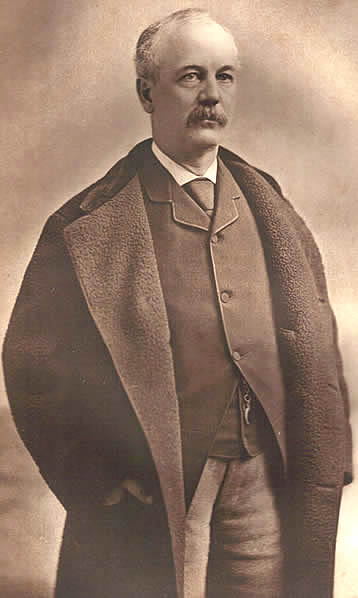
James
Ripley Osgood (b. 1836 - d. 1892)
publisher of first edition of Life on the Mississippi |
When James R. Osgood and Company declared bankruptcy on May 2, 1885, Clemens
acquired the unsold stock of Life on the Mississippi. This inventory,
in turn, was sold to Watson Gill (b. 1837 - d. 1903) of Syracuse, New York
who obtained an exclusive contract to sell the book. Gill had been affiliated
with American Publishing Company and had proven to be a valued associate
for Clemens's own Webster and Company. After declaring bankruptcy, Osgood
went to work for Harper and Brothers as their London agent. After 1894 Andrew
Varick Stout Anthony was also employed by Harper and Brothers.
In December 1894 Clemens wrote to Henry Rogers emphasizing the importance
of recapturing the rights to Life on the Mississippi from Gill so
it could be included in the uniform edition of his works and suggested a
payoff of $700 if necessary. Gill, however, was wanting the rights to publish
an entire uniform edition of Mark Twain's works himself. The negotiations
Rogers conducted with Watson Gill remain unclear. However, in a contract
dated May 23, 1895, Olivia Clemens assigned rights to Life on the Mississippi
to Harper and Brothers. By 1896 Harper had produced new printing plates,
eliminating most of the original illustrations, and was publishing the book
in their own uniform edition series of red
cloth and gold cornstalk bindings. Evidence suggests that Gill may have
threatened a lawsuit to retain his rights in Life on the Mississippi.
However, Rogers assured Harper that he would protect their company from
any legal obstacles that Gill might throw in their way. Gill's claims to
exclusive rights over the work were effectively nullified with Henry Rogers's
assistance and Life on the Mississippi became the property of Harper
and Brothers. The company, through their contractual agreement with American
Publishing Company, allowed Frank Bliss to include Life on the Mississippi
as Volume 9 in the 1899 uniform edition.
Refining the Work
By the agreement between Harper and American Publishing Company dated November
11, 1898, Frank Bliss was allowed to manufacture new printing plates that
would immediately become the property of Harper and Brothers. By producing
a new set of plates in Hartford, Bliss could save transportation costs and
insurance involved in shipping the plates from New York.
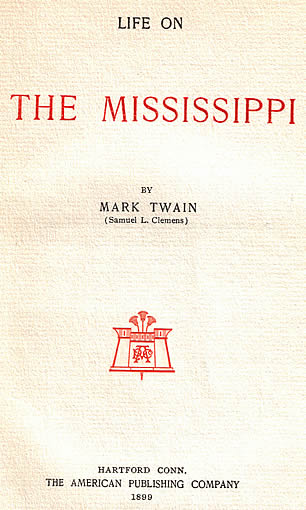
Title
page features American Publishing Company logo. |
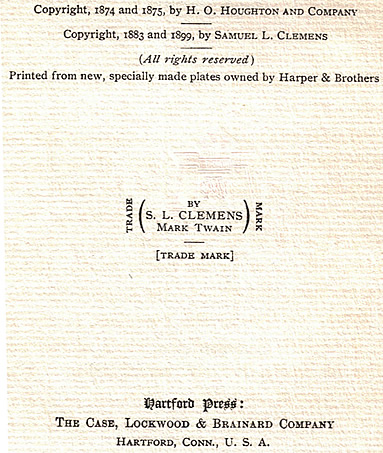
Copyright
page printed on the back of the title page features the Mark Twain trade
mark and a statement that the printing plates were owned by Harper and
Brothers. |
The 1899 uniform edition of Life on the Mississippi offered Clemens
an opportunity to revise and refine his work. However, there is little evidence
to suggest he took an active interest in doing so. The 1883 first edition
of Life on the Mississippi featured a Mark Twain trade mark. Clemens
had recently lost a copyright
infringement suit against Belford & Clarke Company in January 1883.
Clemens was hoping the printing of the trade mark on his books might improve
his chances of winning if he attempted future lawsuits. In a letter to his
British publisher Andrew Chatto, on March 1, 1883 he explained:
The new round of typesetting had the potential to introduce new errors
into the text. One such example is the heading for Chapter 36 (Life on
the Mississippi, Volume 9, p. 285). The correct chapter heading from
the first edition is "The Professor's Yarn." In the 1899 editions,
the chapter heading reads "The Professor's Gain." The error was
corrected for the Riverdale
and Underwood Editions
which Bliss published in 1901.
|
Frank Bliss intended to correct any errors for subsequent printings
and hired Forrest Morgan (b. 1852 - d. 1924), a fastidious proofreader,
to weed out errors. Morgan, a former editor of the Hartford Travelers
Record and later an assistant librarian at Watkinson Library in
Hartford, read from a set of the Royal
Edition to mark errors.
Clemens was familiar with the work of Forrest Morgan in Travelers
Record. When Clemens wrote "Stirring Times in Austria"
in 1897 he quoted from a long passage he credited to Morgan to describe
the history of disunity in the Austro-Hungarian empire. "Stirring
Times in Austria" was published in Harper's Monthly in
March 1898 and is reprinted in Volume 22.
Morgan's 22-volume set of the Royal Edition with his annotations
is in the Beinecke Rare Book and Manuscript Library at Yale University,
a gift from William Lyon Phelps in 1922.
No examination of Morgan's notes for Life on the Mississippi
has been conducted.
|
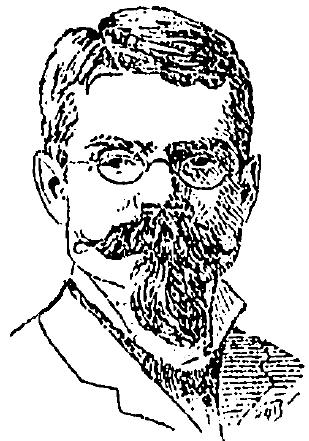
Forrest
Morgan, proofreader for the 1899 uniform edition, helped refine the
works for subsequent editions. |
W. H. W. Bicknell's Contributions
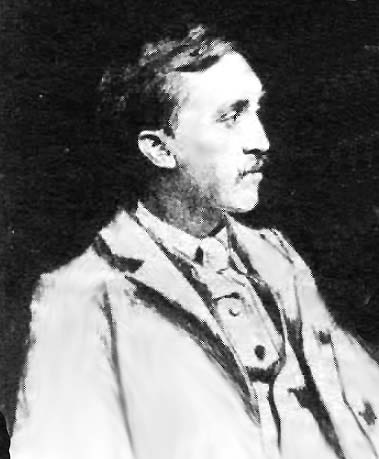
William
Harry Warren Bicknell
photo courtesy of the Winchester, Massachusetts Archival Center |
Frank Bliss hired new illustrators for the 1899 uniform edition.
Artist and etcher William Harry Warren Bicknell (b. 1860 - d. 1947)
was born in Boston, Massachusetts, the son of a grocer. Bicknell graduated
from the Boston Latin School in 1878 and later studied at the Boston
Museum of Fine Arts. He was a pupil of Otto Grundmann and Frederic
Crowningshield. Bicknell etched a number of frontispieces made from
photographs of Clemens that were used throughout the set. Bicknell's
etching of the Tiffany monogram appears as a title page in every volume
of the Autograph Edition,
Edition De Luxe, Japan
Edition, Author's
De Luxe Edition, and the Royal
Edition. All of these editions began issuing in 1899.
Less expensive editions such as Underwood,
Riverdale, and
Hillcrest feature the Tiffany title
page in Volume 1 only. It was elimnated altogether from the Author's
National Edition.
|
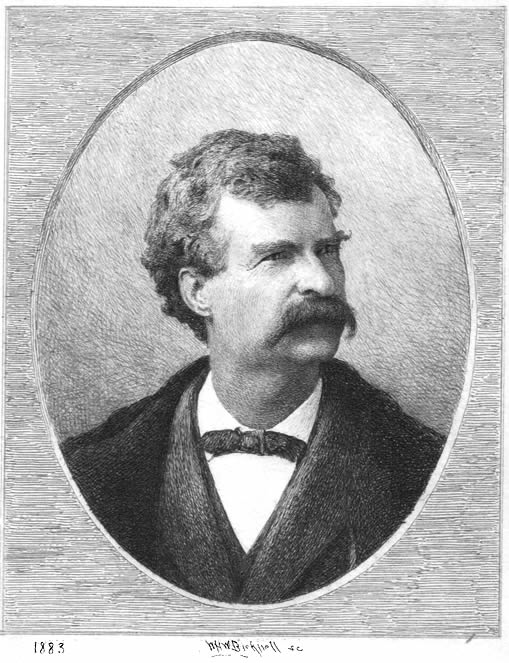
Frontispiece
of Volume 9 etched by William Harry Warren Bicknell based on a photograph
of Mark Twain in 1883.
Bicknell's frontispiece for Life on the Mississippi is
identified as being from a photograph taken in 1883. However, the engraving
closely resembles the known photographs
of Clemens made by Napoleon Sarony prior to the fall of 1884 when Clemens
and George Washington Cable visited Sarony's studio in New York.
Edmund Henry Garrett, Illustrator
|
Edmund Henry Garrett (b. 1853 - d. 1929) was born in Albany, New
York. Both of his parents were born in France. When he was a youngster
the family moved to Boston where he attended the public school. According
to the 1870 census, his father Anthony worked in a Boston iron foundry.
Garrett's artistic career began in woodcarving and he later developed
his talent for painting. He began illustration work for newspapers
and magazines at age twenty. Garrett later traveled to Paris where
he studied under Jean Paul Laurens, Jules Lefebyre, and at the Academy
Julian. After traveling extensively abroad, Garrett settled in Winchester,
Massachusetts. Garrett also wrote and collaborated on several books
including Elizabethan Songs (1891), Three Heroines of New
England Romance (1894), The Romance and Reality of the Puritan
Coast (1897), and The Pilgrim Shore (1900).
|
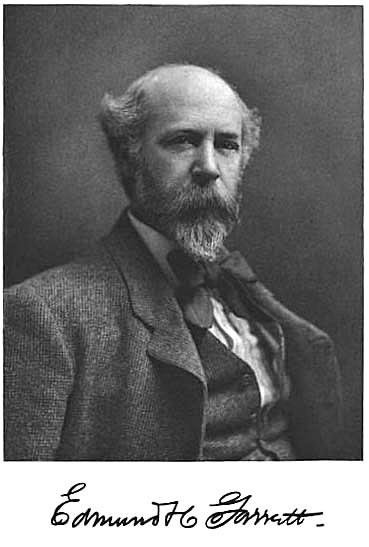 |
Garrett helped illustrate the 1883 first edition of Life
on the Mississippi. Frank Bliss arranged with Garrett to contribute
five new illustrations to the 1899 uniform edition of the book. Garrett
used the opportunity to improve upon the original unsigned work, selecting
scenes from the text that had been previously illustrated. One receipt for
his work dated July 1, 1899 indicates Garrett was receiving $50 per drawing
for the new work.
One illustration Garrett drew is a scene from the text titled
"You Take Her and Lie Awhile" from Chapter 24. The same scene
had been previously illustrated by artist John J. Harley. Evidently, Garrett
felt that Harley's illustration did not properly depict the humor in the
text.
|
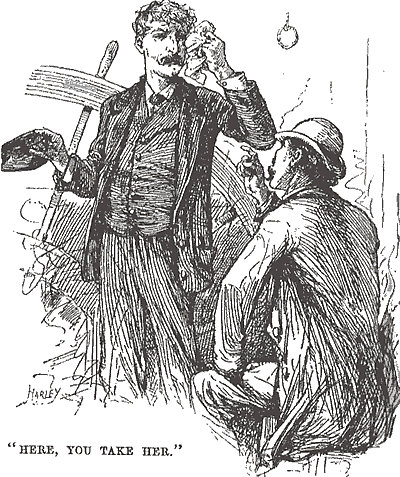
John
J. Harley's illustration from the 1883 first edition (Chapter 24)
features a conversation between Mark Twain and a tired and disgusted-looking
steamboat pilot.
|
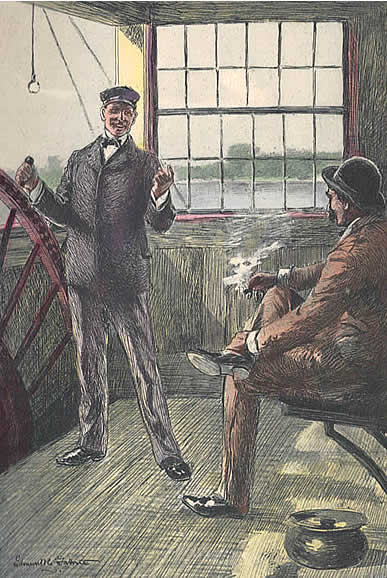
Edmund
H. Garrett's "You Take Her and Lie Awhile" from the 1899 uniform
edition features the same steamboat pilot (Chapter 24) who is smiling
and enjoying the joke. The illustration was hand-colored and used as
a frontispiece for the 1901 Riverdale
Edition. |
References
"Arthur
Lumley's Remembrances of the Late A. V. S. Anthony," The New York
Times, 28 July 1906, p. BR 478.
Clemens,
Samuel L. to Andrew Chatto, 1 March 1883. Original letter in the Kevin Mac
Donnell collection.
"E.
H. Garrett, Artist, Dies In Needham," The New York Times, 3 April
1929, p. 25.
Garrett,
Edmund Henry and William Howe Downes. Bookplates Selected from the Works
of Edmund H. Garrett and a Notice of Them. (The Troutsdale Press, 1904).
Online via google books.
Garrett,
Edmund H. Receipt to American Publishing Company for two drawings. 1 July
1899. Accession No. 6314, Box 8. (University
of Virginia Library, Special Collections).
Hill,
Hamlin, ed. Mark Twain's Letters to His Publishers, 1867-1894. (University
of California Press, 1967).
Leary,
Lewis, ed. Mark Twain's Correspondence with Henry Huttleston Rogers 1893-1909.
(University of California Press, 1969).
"Obituary
Notes: Andrew Varick Stout Anthony," Publishers' Weekly, 7 July
1906, p. 19. Online via
google books.
Palmquist,
Peter E. and Thomas R. Kailbourn. Pioneer Photographers of the Far West:
A Biographical Dictionary, 1840 - 1865. (Stanford University Press, 2000).
Rasmussen,
R. Kent. Critical
Companion to Mark Twain, Volumes I and II. (Facts on File, 2007).
Twain,
Mark. Life on the Mississippi. Edition De Luxe. (American Publishing
Company, 1899).
_____.
Life on the Mississippi. (Oxford University Press, 1996).










